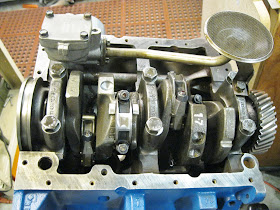Here are the four piston & connecting rod assemblies. The new pistons are 0.031" oversize. At this point all four have been in the engine [without piston rings] so the bearing clearances could be checked with plastigage. The bearing clearances averaged 0.00175". The original connecting rod bolts and nuts have been replaced with new high strength Ford V8 parts. The six small bolts in the photo are not part of the piston/rod assembly.
This is by far the best way to install piston rings, using an inexpensive piston ring expander pliers. You always need to read the instructions that come with the rings. There is usually a peen mark on some of the piston rings that indicates that side of the ring must be installed UP [toward the top of the piston]. I arrange the piston ring end gaps so they are 120 degrees apart when in place on the piston.
The piston/rod assembly is ready for installation in the engine block. A ring compressor tool is in place, and has compressed the piston rings. The yellow items on the connecting rods are flexible plastic protectors, to keep guide the rod over the crankshaft journal and prevent the rod bolts from damaging the journal.
Not a great photo, but it shows the piston being inserted into the block [top left]. I use a small hammer with a wooden handle to tap the piston/rod assembly into place in the block. Note that pistons have a notch in thier crown, indicating that the piston must be installed with the notch pointing to the FRONT of the block.
In this photo, all the rod caps are in place and torqued to 25 ft/lb. I use a bit of Loktite on each of the bolts as a bit of added insurance that a nut will NOT come loose. Note that a new oil pump has been installed [with a NEW oil pump drive shaft] and that the oil pick up strainer is completely clean. I squirt as much engine oil into the new oil pump as it will hold before I bolt it in place. Note the "1.7" on the second crankshaft counterweight from the front, indicating that it is a 1700 crankshaft. At this point, the lower end of the engine is "buttoned up" and ready for the oil pan to be installed.





No comments:
Post a Comment
Note: Only a member of this blog may post a comment.